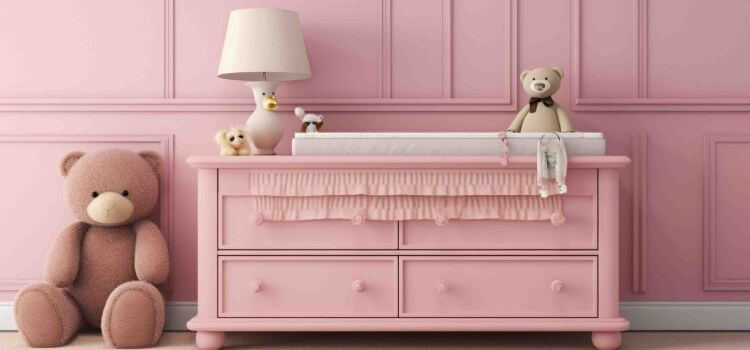As an Amazon Associate I earn from qualifying purchases.
When it comes to attaching a changing pad to a dresser, safety is of paramount importance. Begin by selecting a non-slip changing pad; many come with a strap to secure them to the dresser. Position the changing pad on the dresser where you find it comfortable to reach. Then, locate the security strap, which is usually found at the bottom of the pad. This strap needs to be attached to the back of the dresser. Depending on the type of dresser and pad, you might need screws to secure the strap. Always ensure the strap is tightened enough so that the pad doesn’t move around. Lastly, double-check all your work to ensure that everything is secure.
Remember, never leave your child unattended on the changing pad.
In this guide, we are going to walk you through each step to ensure that your changing pad is secure and safe for your baby.

Gather the Necessary Materials
Before getting started, it’s essential to have all the necessary materials on hand. Here’s what you’ll need:
- Changing pad
- Dresser or changing table
- Non-slip pads or rubber mat
- Safety straps or Velcro (usually included with the changing pad)
- Screwdriver
- Screws (if not included with the safety straps)
Preparing the Dresser

To begin, thoroughly clean and dry the top surface of the dresser where you plan to attach the changing pad. This will ensure a strong bond between the two surfaces. If necessary, use sandpaper to smooth out any rough areas or bumps on the dresser.
Next, measure and cut a piece of non-slip material to fit the size of your changing pad. It will provide an extra layer of grip and stability for the changing pad.
Choose the Right Changing Pad

Before you can secure your changing pad to the dresser, you need to make sure that you have the right one. Some changing pads come with straps or screws for attaching them to a dresser, while others may require additional materials. Make sure to read the instructions and check if extra materials are needed before purchasing a changing pad.
Attaching the Straps or Velcro

Place the non-slip pads or rubber mat on the surface of the dresser where you plan to position the changing pad. These pads will provide extra grip, preventing the changing pad from sliding around on the smooth surface of the dresser.
Most changing pads come with safety straps or Velcro to secure them to the dresser. If yours doesn’t, you can purchase these separately. Attach the straps or Velcro to the changing pad following the manufacturer’s instructions. This usually involves screwing one end of the strap to the back of the dresser and the other end to the back of the changing pad.
Testing for Stability.
After securing the changing pad, test its stability by gently pressing down on different areas of the pad. It should not move or shift at all. If you notice any movement, tighten the straps or screws accordingly until the pad is completely stable.
Maintenance
Regularly check and tighten the straps or screws as needed to ensure that the changing pad remains secure. Also, make sure to clean and disinfect the pad regularly for your baby’s hygiene and safety.
Safety Tips
Here are some vital safety tips to keep in mind while using a changing pad:
- Never leave your baby unattended on the changing pad.
- Always use the safety straps, even if you think the pad is secure.
- Regularly check the stability of the changing pad, especially after cleaning the dresser.
- Make sure the dresser or changing table is sturdy and stable before placing your baby on the pad.
- Keep all necessary changing supplies within arm’s reach to avoid having to step away while your baby is on the pad.
Recommended Products
While we don’t endorse any specific products, we suggest looking for changing pads that come with safety straps or Velcro included. Some changing pads even have non-slip bottoms, eliminating the need for a separate rubber mat. When choosing a changing pad, ensure it is soft, comfortable, easy to clean, and fits nicely on your dresser or changing table.
Conclusion
Securing a changing pad to a dresser is essential in creating a safe environment for your baby. While it may seem like a minor detail, it can significantly impact your baby’s safety. Following the steps outlined in this guide, you can ensure that your changing pad is securely attached, providing a safe and comfortable space for changing your baby’s diapers. Remember, safety should always be your top priority for your little one.
Amazon and the Amazon logo are trademarks of Amazon.com, Inc, or its affiliates.
Leave a Reply